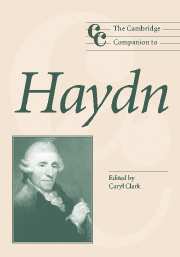Book contents
- Frontmatter
- Part I Haydn in context
- Part II Stylistic and interpretive contexts
- Part III Genres
- Part IV Performance and reception
- 14 A composer, his dedicatee, her instrument, and I: thoughts on performing Haydn's keyboard sonatas
- 15 Haydn and posterity: the long nineteenth century
- 16 The kitten and the tiger: Tovey's Haydn
- 17 Recorded performances: a symphonic study
- Notes
- Bibliography
- Index
14 - A composer, his dedicatee, her instrument, and I: thoughts on performing Haydn's keyboard sonatas
from Part IV - Performance and reception
Published online by Cambridge University Press: 28 September 2011
- Frontmatter
- Part I Haydn in context
- Part II Stylistic and interpretive contexts
- Part III Genres
- Part IV Performance and reception
- 14 A composer, his dedicatee, her instrument, and I: thoughts on performing Haydn's keyboard sonatas
- 15 Haydn and posterity: the long nineteenth century
- 16 The kitten and the tiger: Tovey's Haydn
- 17 Recorded performances: a symphonic study
- Notes
- Bibliography
- Index
Summary
In the 1790s Haydn made two extended trips to London. It is during his second, in 1794–95, that he composed his “Grand Sonata” for Piano in C major, Hob. XVI:50. The following three narratives describe its opening measures (shown in Ex. 14.1), each from a different perspective. We first take the score off a library shelf, and read it:
Narrative 1
A naked triad, in the simplest of keys, is spelled out, matter of factly, without any trace of hurry. But gradually, as if adding spice to a bland dish, Haydn throws in dissonances. First, a passing tone D between E and C. Then, on the downbeat of measure 3, an upper neighbor F, which resolves to E by the middle of the measure. (This relationship is marked as “y.”) But this upper neighbor (or appoggiatura, that quintessential eighteenth-century ornament) was itself preceded by a lower one. (Marked as “x.”) To understand this double tension is as essential as it is puzzling. On the one hand, a slur (which, according to mid- to late eighteenth-century German sources, marked the first tone as the more expressive one) conveys the message that E is an embellishing tone to F. But the usual interval of a second (two adjacent tones imitating the inflection of a “sigh”) has here been inverted to a seventh. Does this inversion allow F to emancipate itself from the preceding E? If so, does F challenge the dissonance status of E, which should actually be understood as a consonance? In other words: which should be believed, x or y? With delightful delay measure 6 answers this sophistic question: not only is the second-interval restored to a dissonance–consonance pair; the effect of a slur – strong/long first tone, soft/short resolution – is materialized by no less than three performance directives: sforzando, fermata, and diminuendo. We now skip a few pages and look at mm. 120 ff. which harmonize this passage. “Y or x” does not matter any more: E and F have both become part of a descending chain of suspensions, adjusting to the laws of voice leading and counterpoint, fluidly moving in and out of dissonance or consonance status.
- Type
- Chapter
- Information
- The Cambridge Companion to Haydn , pp. 201 - 225Publisher: Cambridge University PressPrint publication year: 2005
- 26
- Cited by



